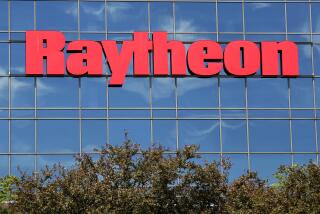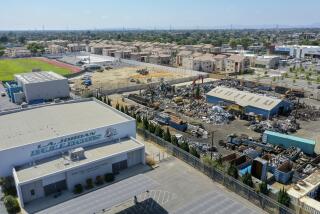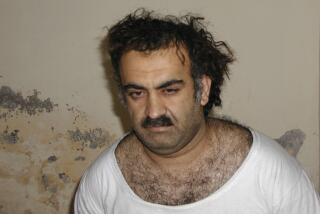Rockwell Agrees to Record Fine in Fatal Blast
- Share via
SANTA SUSANA PASS — In a plea bargain worked out with federal prosecutors, Rockwell International has agreed to plead guilty to three federal felony counts and pay an unprecedented $6.5-million fine in connection with the 1994 chemical explosion that killed two scientists at the firm’s Santa Susana Field Lab in Ventura County.
U.S. Atty. Nora Manella called a news conference at her Los Angeles office Monday morning to announce the plea agreement signed by Rockwell in the July 26, 1994, blast that killed physicists Otto K. Heiney and Larry A. Pugh.
“This is not a case where the law failed us,” Manella said. “There are laws on the books, and had they been observed, these two scientists would be alive today.”
Two hours later, Rockwell CEO Donald Beall called a separate news conference at the firm’s Rocketdyne division headquarters in Canoga Park in the San Fernando Valley, admitting that the deaths of Pugh and Heiney were “a corporate failure for which we accept responsibility.”
Beall and Rocketdyne President Paul Smith denied that they had any knowledge of the illegal disposal of a volatile explosive before it was exposed by a multi-pronged, 21-month state and federal investigation into the blast.
But while the company had maintained for months that Heiney and Pugh were doing legitimate experiments, Smith admitted Monday that the two triggered the blast while illegally burning the substance to get rid of it.
*
The dead men’s widows filed wrongful-death suits against Rockwell, Rocketdyne, Beall and Smith, but settled out of court in February for undisclosed amounts.
On Monday, Antoinette Pugh declined to comment from her Newbury Park home, except to say, “I’m just stunned.”
Reached at her home in Shalimar, Fla., Judith Heiney said: “I had expected the fine to be larger. I suppose justice is done the way the system works.”
But Heiney was reluctant to criticize Rockwell, saying she is grateful that the matter was finally resolved.
“I’m pleased that it is finally coming to an end,” she said. “I wish it had never happened.”
Under terms of the agreement, Rocketdyne officials were to have pleaded guilty Monday in U.S. District Court to two counts of illegal disposal of hazardous waste and one count of illegal storage of hazardous waste.
But U.S. District Judge Mariana R. Pfaelzer delayed a decision on whether to accept the plea and impose sentence until 1:30 p.m. Thursday, saying she needs more time to review court documents.
Noting that she had read the case documents only once, Pfaelzer said, “It’s not something I fully understand.”
At the earlier news conference, Manella called Rocketdyne’s agreement to write the U.S. government a check for $6.5 million “the largest fine ever assessed in a hazardous waste case in the state of California.”
But one environmentalist called it “like a slap on the wrist” for a company taking in billions every year in defense contracts that allowed two of its employees to be killed.
“It looks like, once again, the government has caved when it comes to enforcing the laws where big corporations are involved,” said Dan Hirsch, president of a Los Angeles-based national environmental watchdog group called the Committee to Bridge the Gap.
*
As part of the agreement, Rockwell officials have promised to help U.S. prosecutors and a federal grand jury investigate possible criminal charges against still-unnamed Rockwell employees who approved the illegal burning.
For one thing, the company agreed to finally turn over its internal investigative records of the explosion, which the FBI subpoenaed last July.
In exchange for that agreement and the promise of a guilty plea, the U.S. attorney’s office granted Rocketdyne limited immunity.
Prosecutors agreed not to charge the firm for any other crimes committed before the agreement is ratified in court that might involve illegal disposal, illegal handling, workplace safety or contract fraud related to hazardous waste.
Rockwell is also working closely with the U.S. Department of Defense to avoid any debarment or limitations on its lucrative aerospace and electronics contracts with the government, said Smith.
And the plea agreement hints that the ongoing investigation will focus not only on Rocketdyne workers’ roles in the blast and illegal disposal, but on the activities of UXB, the Maryland-based firm hired to clean up the volatile explosives at the field lab in the months following the fatal blast.
Heiney, 53, and Pugh, 51, worked for Rocketdyne’s chemical technology department, which researched gun propellants and flares designed to decoy heat-seeking missiles away from military targets.
The men spent much of their workweek at the field lab, a large complex of test stands and laboratory buildings that sprawls across 2,700 rocky acres atop the Santa Susana Mountains between Northridge and Simi Valley.
On July 21 and 26, 1994, Rocketdyne admits, the two physicists were disposing of triaminoguanidine nitrate, or TAGN, a highly volatile chemical used in gun propellants.
Heiney, Pugh and three other Rocketdyne employees had already burned off one batch. They had spread some of the chemical in a metal tray atop layers of sawdust, nitrocellulose and glycidal azide polymer and a device called an electric match, then retreated to a blockhouse to ignite it.
One of the five apparently returned to the still-hot test pans with a container of TAGN, which blew up in the men’s faces, instantly killing Pugh and Heiney and burning test engineer Lee Wells, who stood 10 to 15 feet away.
The day after the blast, Rocketdyne President Smith told reporters that the men were conducting legitimate tests, using sonic probes to measure “overpressure” waves from the blasts and determine how the nitrocellulose and glycidal azide polymer should be handled.
But on Monday, Smith admitted that a Cal/OSHA investigation had found the truth--that the men were illegally burning 160 pounds of TAGN, a little bit at a time, to dispose of it.
Rockwell had no disposal permit, and had already been illegally storing the stuff without a permit for 55 days. And, Smith said, there was no evidence that the men at the test stand had collected any data from the tests.
Since the blast, Rocketdyne has fired or suspended without pay some of its employees, but Smith on Monday refused to say who or how many.
And it remains unclear how much the guilty pleas will hurt Rockwell itself.
The huge contractor depends on the government for 28% of its revenue, working for the Defense Department, the Navy, the Air Force and NASA.
Rocketdyne itself developed nearly every rocket engine used in the U.S. manned space program and continues to do electronics work on such projects as the power plant for the U.S. space station.
In a similar criminal case in 1992, the company suffered little market damage when it paid an $18.5- million fine and pleaded guilty to five felonies and five misdemeanor charges over its hazardous waste cleanup efforts at the Rocky Flats, Colo., nuclear facility.
The Justice Department, however, has agreed as part of Monday’s plea agreement to remain neutral when asked for its advice on potential contract suspension, said Assistant U.S. Atty. William Carter. “We would just tell whoever asked that the company is cooperating with us,” he said.
If there are no long-term financial drawbacks and no more disclosures of ineptitude, then the fallout from the guilty pleas should not be wrenching, says Margarethe Wiersema, a corporate strategies specialist and associate professor at UC Irvine’s graduate school of management.
“You can’t be seen to be callous and uncaring,” she said, but noted that the episode probably isn’t as damaging as it sounds “because these kinds of things seem to occur regularly” in defense contracting.
“That may be because the client is the government, so things get investigated a lot more and a violation is automatically a crime,” she said. “It’s the nature of the beast.”
In the Rocky Flats case, the government never sought to bar Rockwell from obtaining other federal contracts, and Rockwell’s stock price barely reacted. It has more than doubled since then, despite a drop of $3.125 a share Monday.
Stock value is affected by negative publicity, Wiersema said, but it is uncertainty that prolongs the damage.
When the Exxon Valdez dumped almost 11 million gallons of crude oil into Alaska’s Prince William Sound in 1989, Exxon Corp.’s stock dived until investors got a sense of the potential liabilities the company faced.
“It was beat up because the costs of the cleanup and of pending litigation against the company were unknown,” Wiersema said. “But now that those issues have been resolved, the stock has recovered.”
Rockwell is likely to get a corporate black eye, but if the case is seen as a “random act of carelessness and not symptomatic of further, major problems throughout the company,” that black eye will heal, she said.
Times staff writers Mary Pols and John O’Dell and correspondent Michael Krikorian contributed to this report.
* RELATED STORY: A3
More to Read
Sign up for Essential California
The most important California stories and recommendations in your inbox every morning.
You may occasionally receive promotional content from the Los Angeles Times.










